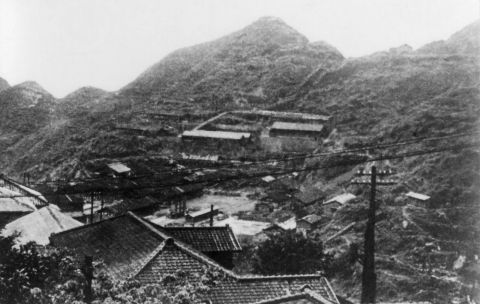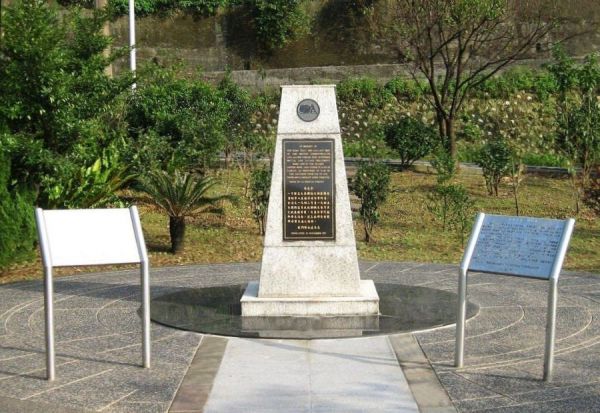

Kinkaseki Camp #1
Camp Opened: 11/14/1942 - Camp Closed: 06/30/1945
 Photo of Kinkaseki POW Camp 1946
Photo of Kinkaseki POW Camp 1946
On November 14th 1942 in the village of Jinguashi, located on the northeast coast of Taiwan, 523 allied POWs began what was to be for some a three year ordeal as slaves in the largest copper mine in the Japanese Empire. In all more than 1,100 British Commonwealth and Allied prisoners of war slaved in this notorious Japanese POW camp called KINKASEKI from December 1942 to March 1945.
The men had arrived in the camp after a journey of some three weeks on the hellship England Maru which brought them from Singapore following several months as POWs there after the island surrendered to the Japanese in February 1942.
The POW's in this camp were forced to slave in the dark depths of a copper mine and were subjected to the most inhumane treatment imaginable. Conditions in the mine and the camp were as bad, if not worse in many cases, than that experienced by the POW's on the now-famous Railway of Death in Burma and Thailand, which was made popular by the movie "Bridge on the River Kwai".
Daily the men were forced to march up the hill behind the prison camp and down the other side of the mountain to enter the mine. From there they walked approximately 1 1/2 kms inside the mine to the areas where they laboured. Just getting to and from the mine was a huge effort considering the poor physical condition of the men. They were forced to work deep in the mine in places so hot and dangerous that the local Taiwanese and Japanese miners refused to go there. If the men did not meet the quota of work set out for them at the beginning of the day by the Japanese, they were lined up along the walls of the mine shaft and beaten with the hardwood handles of the mining hammers until they were black and blue with bruises and bleeding.
As in all of the POW camps, the food was insufficient and this led to many types of dieases resulting from lack of food and vitamins. Dysentery, pellagra, beri beri, ulcers, pneumonia, diptheria and many other ailments took their toll on the men. Add to this the lack of medicines - and those that were available were often withheld by the Japanese, so that the doctors in the camp had a very hard time trying to keep the men alive. Many men died in the camp and when others became too sick and weak to work in the mine any longer, they were moved out to other camps and replaced by more fit men. This occurred several times during the three years the POWs slaved in the mine.
In early March 1945 the Kinkaseki mine was closed because the ore could not get out to Japan for processing as the allied navies were sinking all of the Japanese convoys. It was decided then to move the men to a camp furtther inland and one was set up in the mountains south of Taihoku (Taipei). In mid-May the first group of POWs left Kinkaseki and later in May and June the rest of the men moved to this new camp called Kukutsu. They remained there in deplorable conditions until the war ended in August.

In 1997 the first of the Taiwan POW memorials was erected on the site of the former Kinkaseki Camp and since then it has become the official Taiwan POW Memorial.
Photo Gallery
<< Back to list page - Email this Page
© COPYRIGHT 1998 - 2025
All material on this website, including articles, maps, photographs, drawings etc. is the copyright of the
Taiwan POW Camps Memorial Society
and/or those people or organizations who have contributed such material. We are happy for material on the Taiwan POW Camps Memorial Society site to be used for schools or research purposes, provided reference is made to its source and/or the owner.
No material may be used on another website or reproduced in any manner by any other means or method without permission from the
Taiwan POW Camps Memorial Society.
All material on this website, including articles, maps, photographs, drawings etc. is the copyright of the
Taiwan POW Camps Memorial Society
and/or those people or organizations who have contributed such material. We are happy for material on the Taiwan POW Camps Memorial Society site to be used for schools or research purposes, provided reference is made to its source and/or the owner.
No material may be used on another website or reproduced in any manner by any other means or method without permission from the
Taiwan POW Camps Memorial Society.














